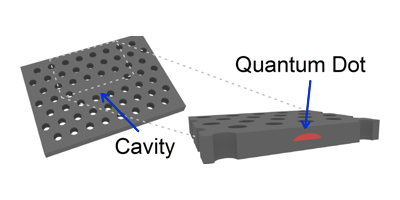Good Vibrations
Lattice vibrations often get a bad reputation because they limit the efficiency of solar cells and degrade the optical quality of solid-state lasers. They can, however, benefit certain light sources. Jelena Vuckovic and colleagues at Stanford University, California, analyzed the light emitted from semiconductor quantum dots coupled to an optical cavity, and found that when the dots interacted with lattice vibrations they behaved as extremely fast single-photon emitters. The effect could be utilized to make quantum light sources that are compatible with integrated circuits in semiconductor technologies.
The authors grew the quantum dots—20-nanometer-wide islands of indium arsenide—on a semiconductor film. They then embedded this structure in a photonic crystal cavity, which is a semiconductor slab with a pattern of holes that traps light in a small region. Exposing this device to pulses of laser light excites polaritons—a hybrid particle that is part electron from the quantum dot, part photon from the cavity—which emit light when they decay.
The polaritons can have a spectrum of energies and therefore emit light over a range of wavelengths. But introducing lattice vibrations, which the authors do by raising the device temperature, favors emission from a polariton mode that efficiently couples light out of the device. This effect turns the quantum dot into a rapid single-photon emitter, which may be used to prepare entangled states, or quantum keys for cryptography.
This research is published in Physical Review X.
–Jessica Thomas





